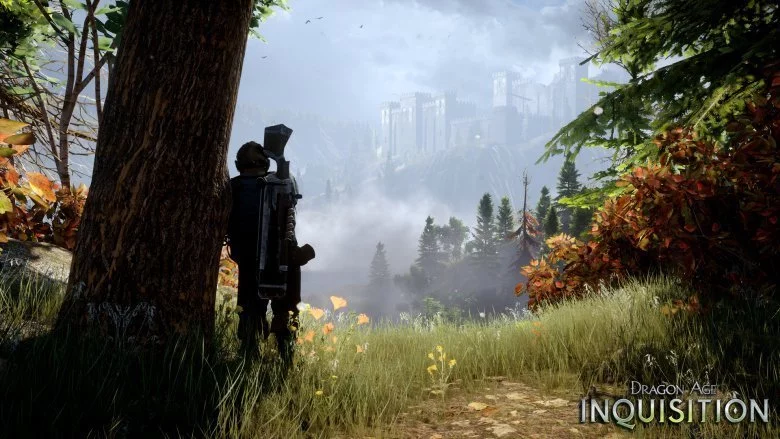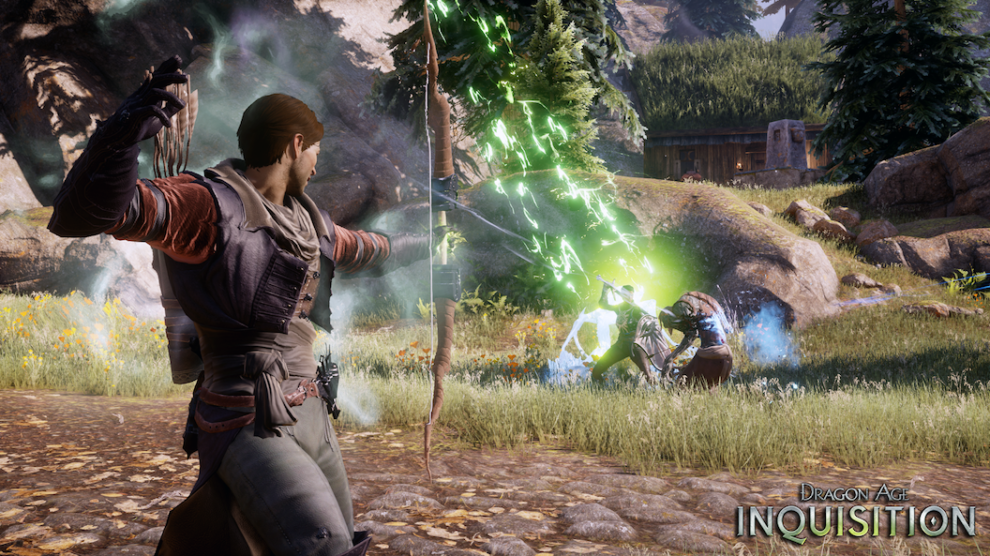Stop me if you’ve heard this one before: an important person is killed, you’re the only one left alive, caught, put in prison and sentenced to death. Then by some act of fate you’re granted the opportunity to clear your name and find answers. Dragon Age: Inquisition has Skyrim and, for that matter, The Elder Scrolls stamped all over it. It’s not a bad thing. These opening stanzas work — quite well, actually — and that’s why developers keep using it.
DA:I takes place after the events of both Dragon Age: Origins and Dragon Age 2; every decision that was made in the first two games has potential to have a meaningful impact in this new iteration. If it’s been awhile since you visited the world of Thedas and you’re unsure of your previous choices, EA has you covered. You can go to Dragon Age Keep and sort through over 300 choices to shape your world and story how you want it. With just a press of the button you can import your world to the console of your choice and it will be waiting for you. It’s a great addition for players, like me, who’ve forgotten some of the events that occurred previously in the franchise. You can also play God by changing the things you wish you’d done differently.
In the beginning DA:I seems straightforward and as mentioned previously, your motivation is to clear your name. Soon things begin to spiral out of control as things are never as cut-and-dry as they seem. Early on you have to make a choice between two factions to get aid from. Choosing one means cutting ties from the other and vice versa. This was such a crucial choice that I kept putting it off to try and discover more information on whom I could trust. Yet, the more I played the more I realized the obvious choices are actually the easiest choices. Not in terms of ease of choice, but the ease at which you know you have to choose.

There are multiple instances when a simple conversation can leave a lasting impact. Confronting a smuggler and telling them their gig is up can just as easily be a confrontation in which you convince the smuggler to use their skills for the benefit of the titular Inquisition. These are the tough ones, because you’re often unsure if the NPC can be swayed or, what dialogue choices need to be used to get them on your side. They’re important to complete though, as each agent you bring to the Inquisition plays an important role by providing more troops, information, and goods.. It’s a different take on strengthening your army instead of doing hundreds of fetch quests. I appreciated this approach a lot as it adds depth and interest to proceedings.
Speaking of depth, it’s an area where DA:I truly shines. It’s noticeable right off the hop with how massive the world really is. We’re not talking about using the same piece of environment several times over to give the impression of size either. Thedas is a big place and this is the first Dragon Age game that really gets that vision across. Gone are the linear entry points into small sections of the world that the developers want you to explore. Gone are the multiple trips to one area to do different missions. Instead, in their place is an open, vibrant, richly detailed world with some truly majestic set pieces. There is also a great deal of variety between the different sections of the world as you explore them, from a lush forest, to a barren desert, and even a creepy swamp. Of course there are a plethora of caves and dungeons to explore as well.
The main story takes you to many of these areas for a wide assortment of missions. The plot concerns the tear in the Veil that separates the world from the Fade. The tear allows demons to come through Rifts and cause havoc. It’s your quest to close all the Rifts and ultimately the tear, but you can’t do it alone. You’ll need to build an army to fight to the Breach and close the tear once and for all. On top of that, the more you explore the more people you’ll come across, bodies you’ll loot, and mysterious notes you’ll find. These open up the hundreds of side-quests on offer. Some side-quests allow you to add strength to your army upon completion, while others put you in good standing with others who help spread the word about the Inquisition. That, in turn, causes others to join your crusade. Truth be told, I’ve done a lot of side-quests in this game — probably in the neighbourhood of 50 plus — yet, I never felt that I’d repeated an action. They were all different enough, or at least in very different locales so that they all seemed unique. That’s an amazing feeling for a game this large.

Having a large world and a lot of stuff to do is all well and good, but if the gameplay isn’t fun, none of the other stuff really matters. BioWare obviously listened to their fans as there are bits of fast-paced action in equal proportion to stints of tactical micro-management.
It’s easy to switch between party members to get the most out of their abilities, or you can use only one character and let the others fend for themselves. When I created my character, I picked a rogue so I could use bows for distance and daggers when the action was close-quarters. I had the gear for both… but oddly enough, BioWare made it a hassle to switch between the two. You can really only be one or the other unless you want to become very intimate with the pause screen. If you want to switch, you’ll have to go into your inventory, equip the new weapon and then back out of the menu screen to resume the fight. It’s a very curious decision — and quite cumbersome for the player — and one I am legitimately disappointed in.
One of the things I really liked about Dragon Age: Origins was the skill tree system for each character. It was simple, straightforward, but also with enough depth that I felt like it really mattered as to how I wanted to shape my characters. That skill tree system makes a great return here. Skill trees are divided into four sections depending on the class of the character. It’s very easy to plan out your group for optimal combat effectiveness. Don’t be afraid to experiment with different squad members in your party, there are some great conversations between them as well. I highly suggest having Sera and Vivienne together at least once and listening to their “discussions”.
Another strong addition is the complexity of crafting. There are literally tons of resources for you to find as you harvest and I’d encourage you to pick them all up when you find them, especially the rare ones. You use these different resources to craft potions and tonics, but you can also find weapon and armour schematics and build those items as well. It’s not enough to find a schematic and build something; rather you can tailor its specific build to how you want it. Meaning you can put different resources in different places within the design to get different bonuses. Later on you can craft runes to deal additional elemental damage as well. When you first see how crafting works it’s daunting and somewhat confusing. For those players who really put some effort into it though it will pay off in spades with some pretty kick ass gear. If crafting isn’t your thing, now worries, as you can still loot plenty of gear along the way to get you by.

In a game titled Dragon Age, it’s almost criminal that I haven’t even talked about its dragons yet. There’s a reason for that, because the one dragon I have come across kicked my ass, turned me into BBQ and laughed while doing it. Seriously, most dragons in games of this type are usually pushovers right near the start and are treated more like appetizers of things to come. I’m not sure if I was drastically underpowered when I ran into my first lot as I chose to explore, but I’m telling you, it wasn’t even a contest. I tried for a good 30 minutes (and with countless deaths) and never killed the thing. I will be going back to get my sweet revenge, but until then I’ll keep running away from the beast. There are still plenty of other baddies to kill, from humans to demons with a few bears mixed in. Like the world there is a great deal of variety which only adds to the game’s charm.
For gamers who want to take a break from questing to play with friends, BioWare has added a new four-player mode. At first I was extremely skeptical of adding MP to a single player game. Yet, I am also a fan of the classic dungeon crawl experience and that’s what the co-op is. It’s all about looting and fighting monsters as the group navigates through a randomly generated dungeon. Making sure the party has every class represented is essential as there are doors and secret passages that only one class can open. Levelling up all your different characters is also rewarding in that you can create unique play styles for each of them. Not every rogue has to be a ranged character and not every warrior has to be the lumbering two-handed great sword swinging tank. It’s a fun change of pace that feels like the core game, but not so similar that it feels like you are always doing the same thing.
I absolutely loved Dragon Age: Origins; it had a multitude of different origin stories and proved to be a great game. I also loathed Dragon Age 2 as it didn’t have the same mystique or allure of the original. It was with some trepidation that I ventured back to Thedas, but it was a journey I am so glad I’ve taken. I have poured hours and hours into the game scavenging for resources, doing side-quests and closing Rifts, all the while trying to romance a certain elven rogue… oh, and playing the actual main story too. That’s the beauty of Dragon Age: Inquisition, you play how you want and there is so much to do, you feel like a kid at a candy store. You want to sample everything no matter how long it takes. I’d go as far to say that this is the RPG the current-generation of consoles has been waiting for. This past year’s wait was more than worth it.
Dragon Age: Inquisition was reviewed using a promotional copy of the game on Xbox One, as provided by the publisher.
Dragon Age: Inquisition
 |
The good
|
The bad
|
Want to know more about our scoring scale?
This article may contain affiliate links, meaning we could earn a small commission if you click-through and make a purchase. Stevivor is an independent outlet and our journalism is in no way influenced by any advertiser or commercial initiative.
























